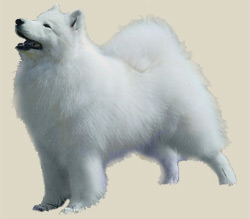
Country of Origin: Russia (Siberia)
Group: Spitz and Primitive types
Section: Nordic Sledge Dogs
Original Function: herding reindeer, guardian, draft
Todays Function: sled pulling, herding trials
Dimension Male: 53-60 cm
Dimension Female: 48-53 cm
Weight Male: 20,5-30 kg
Weight Female: 16-20,5 kg
Litter Size: 4-6 puppies
Life span: 10-12 years
Other Names: Samoyedskaya
Colors: Typical colors for the samoyed are a mixture of white and biscuit coloring. however, all white and a
Living: the samoyed is a dog that will do well in many different environments. this breed will adjust and l
Recognized: CKC, FCI, AKC, UKC, KCGB, CKC, ANKC, NKC, NZKC, APRI, ACR
Description
The compact muscular body of this hard-working breed indicates its strength. The thick, silver-tipped coat comes in white, biscuit, yellow and cream, but pure white is preferred. The Samoyed is a strong, dynamic, active dog. It has a powerful wedge-shaped head with a black or brown nose and strong jaws. Its eyes are dark, oblique and deep. The ears are medium-sized, slightly rounded at the point, and carried erect. The tail is long, full-haired and carried rolled on the back. Its legs are solid and muscular and its feet are flat and covered with hair. Its coat is thick and harsh, not wavy, with a thick, soft undercoat, which protects it against the arctic cold.
Temperament
Gentle and playful, the Samoyed makes a good companion for a child or person of any age. It is a closely bonded family dog. It is amiable with strangers, other pets and usually, other dogs. It is calm indoors, but this clever, sometimes mischievous breed needs daily physical and mental exercise. If allowed to become bored, it will dig and bark. It is independent and often stubborn, but it is willing to please and is responsive to its owner"s wishes. It may tend to herd children.
Excercise
The Samoyed is active and needs a good workout every day, either in the form of a long walk or jog or a vigorous play session. It likes to pull and herd, and it loves cold weather. It can live outdoors in temperate to cold climates, but it much prefers to live indoors with its human family. Its thick coat needs brushing and combing two to three times a week, daily when shedding.
Grooming
Extensive grooming is needed. They are seasonally heavy shedders. The fluffy double coat needs frequent brushing, but tends to stay white without bathing.
Health
Major concerns: CHD
Minor concerns: gastric torsion
Occasionally seen: PRA
Suggested tests: eye, knee, hip

